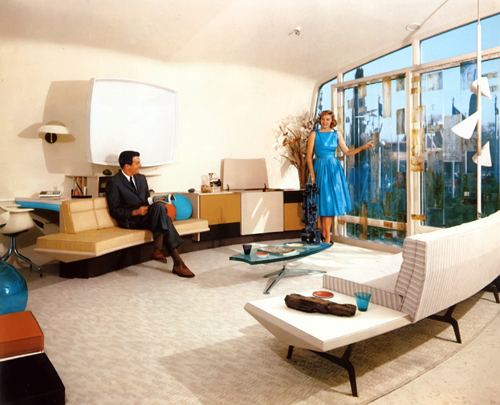Plastic Fantastic Living - Page 4
 |
 |
 |
|
|
But Disney didn’t see the House of the Future as just another attraction—and he took Tomorrowland seriously. “He said he saw Tomorrowland as an opportunity to exhibit things that will affect people for generations to come.”
In any case, Kirwan says, Monsanto couldn’t have found a better place to install its House of the Future—a place with beautiful weather and immense crowds.
The house, which opened to the public in June 1957, was an immediate hit with the public and the press.
“If a dozen of the nation’s leading manufacturers of building products have predicted accurately, the home of tomorrow will be radically different from today’s house,” the New York Times wrote, adding, “It is not just a hoked-up, wildly imaginative novelty.”
“All furniture and furnishings in the model will be plastic,” another publication reported, “with 14 different types of plastics used.”
Families poured through, admiring the curved walls and corners that did not trap dust, the rooms that were as much window as wall, and the scented air conditioning.
“Since the air in each room is individually controlled,” the Wall Street Journal reported, “you can have the living room smell like a pine grove while a bedroom is filled with the scent of roses.”
Special attention was paid to lighting. In the living room, according to the Associated Press, “the overhead lighting fixture resembles a mobile. It has no bulb but draws its light from a projector aimed at it from the floor.”
And when it was time for mom to dress for a night on the town, “special controls [in the vanity] enable the woman making up to simulate the lighting in which she will be seen.”
The all-electric Kelvinator ‘family food center’ was particularly rich with gadgetry. The dishwasher and three refrigerators were stored out of sight, magically appearing at the push of a button.
Ditto the electric range and the microwave oven, quite a novelty at the time. “A steak is cooked by microwave in just 30 seconds,” one paper reported.
This was, moreover, “the first kitchen to make special provision for foods prepared by atomic energy,” The Architect and Building News magazine reported, adding, “a light dose of [gamma] irradiation combined with moderate refrigeration increases the life of many food products by a matter of months.”




